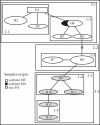Distinctively variable sequence-based nuclear DNA markers for multilocus phylogeography of the soybean- and rice-infecting fungal pathogen Rhizoctonia solani AG-1 IA
- PMID: 21637462
- PMCID: PMC3036909
- DOI: 10.1590/S1415-47572009005000063
Distinctively variable sequence-based nuclear DNA markers for multilocus phylogeography of the soybean- and rice-infecting fungal pathogen Rhizoctonia solani AG-1 IA
Abstract
A series of multilocus sequence-based nuclear DNA markers was developed to infer the phylogeographical history of the Basidiomycetous fungal pathogen Rhizoctonia solani AG-1 IA infecting rice and soybean worldwide. The strategy was based on sequencing of cloned genomic DNA fragments (previously used as RFLP probes) and subsequent screening of fungal isolates to detect single nucleotide polymorphisms (SNPs). Ten primer pairs were designed based on these sequences, which resulted in PCR amplification of 200-320 bp size products and polymorphic sequences in all markers analyzed. By direct sequencing we identified both homokaryon and heterokaryon (i.e. dikaryon) isolates at each marker. Cloning the PCR products effectively estimated the allelic phase from heterokaryotic isolates. Information content varied among markers from 0.5 to 5.9 mutations per 100 bp. Thus, the former RFLP codominant probes were successfully converted into six distinctively variable sequence-based nuclear DNA markers. Rather than discarding low polymorphism loci, the combination of these distinctively variable anonymous nuclear markers would constitute an asset for the unbiased estimate of the phylogeographical parameters such as population sizes and divergent times, providing a more reliable species history that shaped the current population structure of R. solani AG-1 IA.
Keywords: allelic discrimination; multilocus genotyping; polymorphisms; primer design.
Figures

Similar articles
-
Divergence between sympatric rice- and soybean-infecting populations of Rhizoctonia solani anastomosis group-1 IA.Phytopathology. 2008 Dec;98(12):1326-33. doi: 10.1094/PHYTO-98-12-1326. Phytopathology. 2008. PMID: 19000008
-
Phylogeography of the Solanaceae-infecting Basidiomycota fungus Rhizoctonia solani AG-3 based on sequence analysis of two nuclear DNA loci.BMC Evol Biol. 2007 Sep 13;7:163. doi: 10.1186/1471-2148-7-163. BMC Evol Biol. 2007. PMID: 17854492 Free PMC article.
-
Highly polymorphic microsatellite loci in the rice- and maize-infecting fungal pathogen Rhizoctonia solani anastomosis group 1 IA.Mol Ecol Resour. 2008 May;8(3):686-9. doi: 10.1111/j.1471-8286.2007.02048.x. Mol Ecol Resour. 2008. PMID: 21585871
-
The Urochloa Foliar Blight and Collar Rot Pathogen Rhizoctonia solani AG-1 IA Emerged in South America Via a Host Shift from Rice.Phytopathology. 2015 Nov;105(11):1475-86. doi: 10.1094/PHYTO-04-15-0093-R. Epub 2015 Oct 22. Phytopathology. 2015. PMID: 26222889
-
High levels of gene flow and heterozygote excess characterize Rhizoctonia solani AG-1 IA (Thanatephorus cucumeris) from Texas.Fungal Genet Biol. 1999 Dec;28(3):148-59. doi: 10.1006/fgbi.1999.1174. Fungal Genet Biol. 1999. PMID: 10669581
Cited by
-
Population Genetics and Anastomosis Group's Geographical Distribution of Rhizoctonia solani Associated with Soybean.Genes (Basel). 2022 Dec 19;13(12):2417. doi: 10.3390/genes13122417. Genes (Basel). 2022. PMID: 36553683 Free PMC article.
References
-
- Avise J.C. Phylogeography: The History and Formation of Species. Cambridge: Harvard University Press; 2000.
-
- Bernardes-de-Assis J., Peyer P., Zala M., Rush M., McDonald B.A., Ceresini P.C. Divergence between sympatric rice- and soybean-infecting populations of Rhizoctonia solani AG-1 IA. Phytopathology. 2008;98:1326–1333. - PubMed
-
- Brito P.H., Edwards S.V. Multilocus phylogeography and phylogenetics using sequence-based markers. Genetica. 2008;135:439–455. - PubMed
LinkOut - more resources
Full Text Sources
